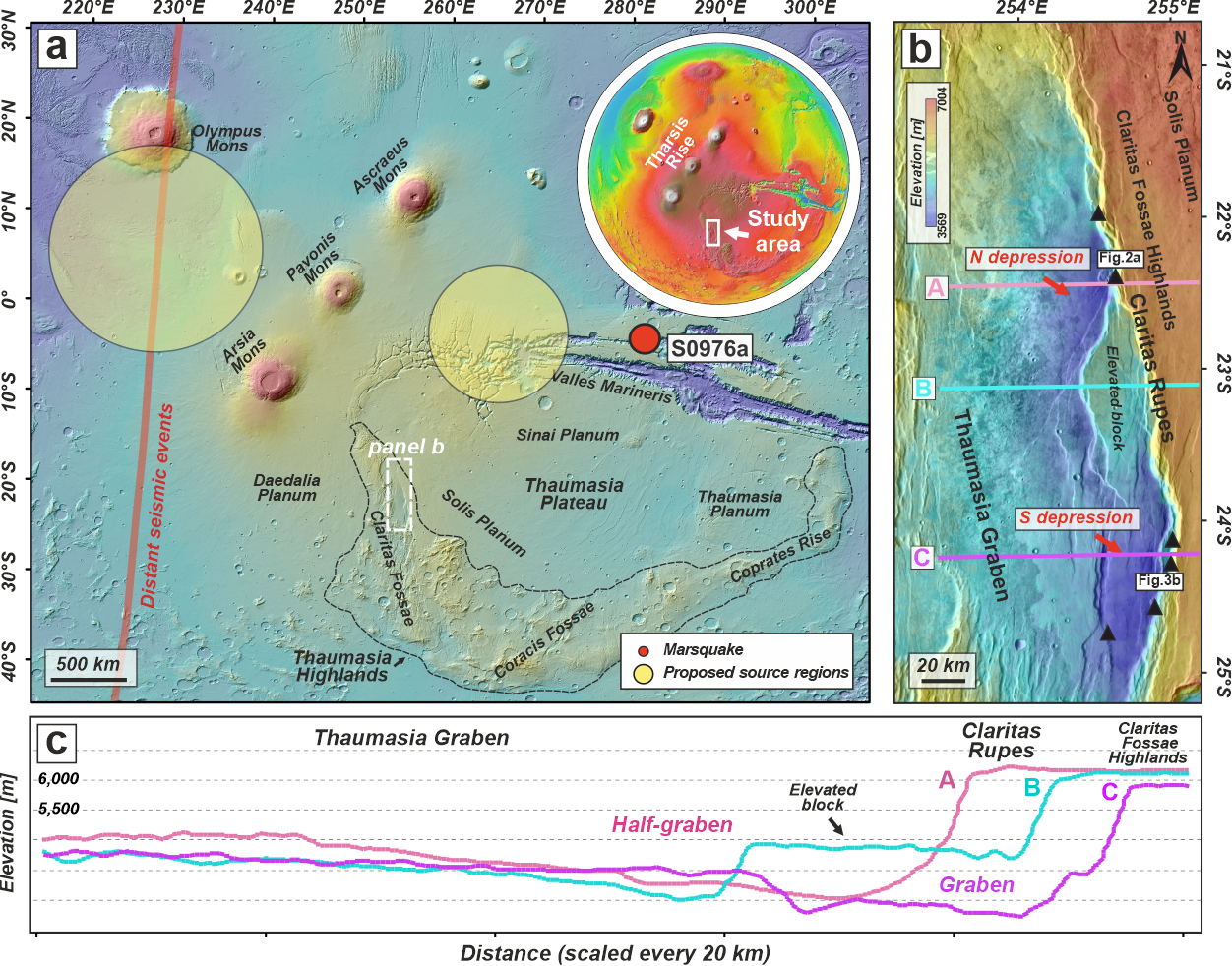Neotectonic activity at the Claritas Rupes scarp, Thaumasia region, Mars
- 1Polish National Institute – National Science Institute, Warsaw, Poland
- 2Institute of Geophysics of the Czech Academy of Sciences, Prague, Czech Republic
- 3Institute of Planetary Research, DLR, Berlin, Germany
Introduction
Current seismic events detected by NASA’s InSight mission suggest that Mars is still seismically and/or tectonically active. Most of the Marsquakes are associated with the Cerberus Fossae region[1,2,3], but the locations of other seismically active centers are poorly constrained [4]. Specifically, recent endogenic activity within Tharsis is poorly constrained although Tharsis-related stresses induced by Late Amazonian volcanic loading[5,6] have likely accumulated within the Martian crust and should lead to recent tectonic activity within this region. To date, only very few morphologically pristine tectonic structures in Tharsis have been documented. Therefore, we followed up on our previous study [7] of the Claritas Fossae region and searched for evidence of recent tectonic structures.

Figure 1 (a) Schematic map of the Tharsis including Thaumasia and Claritas Fossae, our region of interest. Marked by yellow-shaded circles are the positions of proposed source regions of seismic activity of the distant events interpreted for Tharsis [1]. (b) A topographic image of the studied region, the black triangles indicate the locations of investigated fresh-looking scarps. (c) The corresponding topographic profiles of the study region. Produced using the MOLA MEX – HRSC global blended digital elevation model [8].
Observations
The topography of the Claritas Fossae region is dominated by the N020W-trending steep scarp of Claritas Rupes. This scarp, locally exceeding 2,000 meters in height, has been likely formed during the last stage of the main phase of Thaumasia tectonics in the Late Hesperian or Early Amazonian [9]. It was interpreted as the surface expression of a crustal-scale listric normal fault that to the formation of the present regional half-graben morphology [10]. Using the Context Camera (CTX) (5–6 m/px) and High Resolution Imaging Science Experiment (HiRISE) images (25–50 cm/pixel), we identified fresh-appearing scarps with lengths of typically less than one kilometer. Detailed inspection of the scarps reveals uphill-facing (antislope) and pristine morphologies, without evidence of significant modification by erosion or coverage by aeolian deposits. Based on a CTX-based Digital Elevation Model (DEM), we found that the western shoulders of the scarps rise above the inferred average slope of the main scarp, and this topographical offset stops the downslope movement of boulders released from the main Claritas Rupes scarp, leading to their accumulation along the scarps. In some places, where these scarps are not present or less well developed, the boulders were capable of moving further downslope.

Figure 2 (a-b) Examples of identified uphill-facing scarps that stopped and accumulated downslope moving boulders (ESP_078218_1575). (c) Slope map and corresponding CTX-based topographic profile showing that the western shoulders of the scarps rise above the inferred average slope of the main scarp. CTX stereo-pair (P18_007945_1532 and N10_066414_1533) (d) Close-up image of the boulders and their tracks that have been stopped at the antislope scarp (PSP_007945_1555). (e) Schematic drawing presenting the relationship between the uphill-facing scarps and downslope moving boulders (ESP_078508_1555). The north is up.
Discussion and conclusion
The formation of terrestrial uphill-facing scarps is often attributed to Deep-seated Gravitational Spreading Deformations (DGSDs), or instabilities related to glacial retreat. As the studied area does not show any signs of past glaciation(s), neither glacial-induced DGSDs nor post-glacial uplift can readily explain the scarp formation. Uphill-facing scarps could represent antithetic normal faults formed simultaneously or after the formation of the main crustal-scale fault of Claritas Rupes in the Late Hesperian/Early Amazonian [11]. However, this scenario is unlikely due to the pristine morphology of the identified scarps, which argues against such age. Furthermore, their formation could be related to slope gravitational processes such as rotational sliding but we do not find any evidence of the formation of morphologically similar scarps on the other similar-size scarps elsewhere in Tharsis. Nevertheless, the formation of DGSDs can be triggered by the presence of tectonic discontinuities in seismically active regions. Thus, in the context of the long-lived and complex tectonic evolution of the Claritas Fossae region, we infer that that scenario is plausible.
The pristine appearance of the identified scarps suggests that Claritas Fossae might be tectonically inactive. As the determination of absolute (model) ages of small-scale linear tectonic features is almost impossible, we used relative dating. The observed boulders tracks indicate continuous and intense mass wasting processes at the Claritas Rupes scarp that should quickly fill the accommodation space created by the uphill-facing scarps. As a consequence, these small uphill-facing scarps would be covered and precluded from possible identification. Moreover, the pristine appearance of the faults, as visible in image observations and topographic profiles, suggests that the tectonic activity responsible for the fault formation is so young that slope movements and aeolian processes have not yet erased their evidence.
Acknowledgments: BP was financially supported by the Ministry of Education and Science, Poland, with publication grant funding (62.9012.2401.00.0).
References:
[1] Ceylan, S. et al. J. Geophys. Res. Planets 128 (8), e2023JE007826 (2023);[2] Rivas-Dorado, S. et al. Earth Planet. Sci. Lett. 594, 117692 (2022); [3] Horvath, D. G. et al. Icarus 365, 114499 (2021); [4] Stähler, S. C. et al. in 55th Lunar and Planetary Science Conference 2641 (2024); [5] Pieterek, B. et al. Icarus 386, 115151 (2022);[6] Hauber, E. et al. Geophys. Res. Lett. 38, 1–5 (2011); [7] Pieterek, B. et al. 407, 115770 (2024); [8] Balbi, E. et al. Icarus 115972 (2024); [9] Fergason, R. L. et al. US Geol. Surv. (2018) [10] Hauber, E. et al. J. Geophys. Res. Planets 110, 1–13 (2005); [11] Tanaka, K. L. et al. J. Geophys. Res. 93, 893–917 (1988)
How to cite: Pieterek, B., Brož, P., and Hauber, E.: Neotectonic activity at the Claritas Rupes scarp, Thaumasia region, Mars, Europlanet Science Congress 2024, Berlin, Germany, 8–13 Sep 2024, EPSC2024-39, https://doi.org/10.5194/epsc2024-39, 2024.